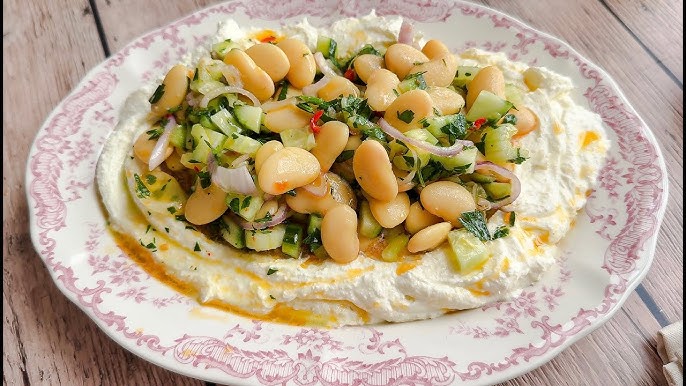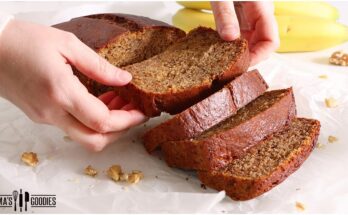Whipped Feta Recipe: If you haven’t tried whipped feta yet, you’re seriously missing out. Imagine everything you love about feta—its tanginess, saltiness, and crumbly texture—transformed into a creamy, luxurious spread. Whipped feta takes humble cheese to an entirely new level of flavor and presentation. It’s the kind of dish that looks gourmet but takes minimal effort to prepare.
The base idea is simple: take feta cheese and whip it together with a few other ingredients like cream cheese, yogurt, olive oil, or lemon juice until it’s light and fluffy. The result? A perfectly spreadable, tangy dip or topping that works with everything from fresh bread to roasted vegetables.
Why It’s So Popular
The rise of whipped feta can be credited to its versatility and stunning presentation. Scroll through Instagram or Pinterest, and you’ll spot bowls of this creamy spread topped with chili oil, fresh herbs, or roasted tomatoes. It’s trendy but timeless, perfect for everything from an easy appetizer to a dinner party showstopper.
Beyond its visual appeal, whipped feta is celebrated for how easily it adapts. Want it richer? Add cream cheese. Need it tangier? Squeeze in more lemon. Like spice? Drizzle with hot honey or crushed red pepper. It’s completely customizable—and totally irresistible.
Ingredients Needed
Main Ingredients
Whipped feta doesn’t need a long list of ingredients. Here’s what you’ll typically need for a classic version:
- Feta Cheese (200g / 7 oz): Always use a good quality block of feta in brine for best results.
- Cream Cheese (100g / 3.5 oz): This adds smoothness and body.
- Olive Oil (2-3 tbsp): For richness and silkiness.
- Lemon Juice (1 tbsp): Brightens the flavors.
- Garlic (1 clove, optional): Adds depth and a bit of bite.
- Salt and Pepper: To taste, but go easy—feta is already salty.
This combo is your creamy, tangy base. From here, you can personalize as much as you like.
Optional Add-Ins for Extra Flavor
Want to make it pop even more? Try tossing in one or more of these:
- Greek Yogurt: Lightens it up and adds more tang.
- Fresh Herbs: Dill, parsley, mint, or basil work beautifully.
- Spices: Smoked paprika, za’atar, or sumac.
- Hot Honey or Chili Oil: For a sweet-spicy kick.
These optional extras let you put your own twist on the traditional whipped feta.
Equipment You’ll Need
Kitchen Tools That Make It Easier
Making whipped feta isn’t fussy, but the right tools help a lot. Here’s what you’ll need:
- Food Processor (or high-speed blender): This is key. A regular blender works too but may need more scraping.
- Spatula: For scraping down the sides and getting every bit out.
- Measuring Spoons: For accuracy with oil, lemon juice, and seasoning.
- Serving Bowl: Presentation matters—go for a shallow bowl so you can top it beautifully.
You don’t need fancy gear, but the smoother your processor, the creamier your feta will be.
How to Make Whipped Feta – Step-by-Step Instructions
Step 1: Choose the Right Feta
First things first—start with the right feta. Not all fetas are equal. Look for a block of feta stored in brine, usually found in the deli section. Avoid the pre-crumbled variety—it’s dry and lacks the creamy potential you need here.
Authentic Greek feta made from sheep’s milk or a combo of sheep and goat milk offers the richest flavor and best texture for whipping. Bulgarian and French versions can also work but may vary slightly in saltiness and tang.
Drain it well but don’t rinse. The brine is what keeps the feta moist and flavorful.
Step 2: Combine the Ingredients
Next, break up your feta and toss it into a food processor. Add your cream cheese (room temperature is best), olive oil, lemon juice, and garlic if using. Don’t worry about precision to the drop—this recipe is forgiving. Just make sure your ratios are roughly:
- 2 parts feta to 1 part cream cheese
- Add liquid (olive oil + lemon juice) slowly as needed
Start pulsing slowly to break everything up before blending.
Step 3: Blend Until Smooth
Now, process on medium to high until you get a smooth, creamy texture. This could take up to 3-4 minutes. Stop occasionally to scrape down the sides with a spatula. You’re aiming for a light, fluffy mixture that holds its shape but spreads easily.
If the texture seems too thick or crumbly, drizzle in more olive oil or a touch of cold water. If it’s too loose, chill it in the fridge—it firms up nicely after 20-30 minutes.
Step 4: Adjust for Taste and Texture
Once smooth, taste it. Add a pinch of pepper, maybe a tiny bit of salt if needed (but be cautious). Want it tangier? Add a bit more lemon. Need more richness? A splash of extra olive oil does the trick.
This is your moment to personalize. Don’t be afraid to get creative.
Serving Suggestions
As a Dip
Whipped feta makes an extraordinary dip—perfect for those nights when you want something impressive with zero stress. Spoon it into a shallow bowl and top it with a generous swirl of olive oil, a sprinkle of smoked paprika, and maybe a handful of chopped fresh herbs. Serve it with:
- Warm pita bread or naan
- Crisp veggie sticks like cucumbers, carrots, and bell peppers
- Toasted baguette slices
- Crackers or pita chips
Want to really wow your guests? Add roasted cherry tomatoes, marinated olives, or crushed pistachios on top for extra flavor and texture.
It’s one of those things that disappears fast, so consider doubling the recipe if you’ve got a crowd.
As a Spread
Spread it on toast and thank yourself later. Whether you’re building a Mediterranean-style breakfast or just need a quick snack, whipped feta on bread is magic. Try pairing it with:
- Avocado and chili flakes
- Sliced tomatoes and balsamic drizzle
- Soft-boiled eggs and arugula
- Roasted peppers or caramelized onions
This isn’t just about flavor—it’s about layers. The creaminess of the feta elevates even the most basic slice of toast to café-level brilliance.
As a Topping
Use it as a creamy finishing touch for other dishes. Dollop whipped feta onto:
- Roasted vegetables like carrots, zucchini, or beets
- Grilled meats like chicken, lamb, or steak
- Grain bowls with quinoa, lentils, or rice
- Pasta dishes in need of a tangy punch
It’s like having a secret ingredient that turns everyday meals into something special. That bit of tang and richness adds contrast and balance in all the right ways.
Flavor Variations to Try
Mediterranean Style
Want to stay close to the roots of feta? Go Mediterranean. Add:
- A few sun-dried tomatoes or roasted red peppers into the blend
- Fresh oregano or thyme
- A dash of za’atar on top
Pair this version with warm flatbread, olives, and grilled eggplant, and you’ve got a mini Greek feast.
Spicy Whipped Feta
Feeling bold? Turn up the heat. For a spicy version:
- Add crushed red pepper flakes or a fresh chili when blending
- Top with chili oil or hot honey
- Sprinkle with Aleppo pepper or cayenne
This version pairs beautifully with crispy chicken wings, grilled corn, or even as a spicy toast topper.
Herbed Feta Blend
Herbs can totally change the personality of your whipped feta. Think:
- Dill and chives for a bright, fresh finish
- Basil for a pesto-style twist
- Mint and lemon zest for a summery vibe
Fold in finely chopped herbs right at the end, so you preserve their color and freshness. This version is great with roasted potatoes, lamb burgers, or summer salads.
Storage Tips
How Long It Lasts
Whipped feta holds up surprisingly well in the fridge. Store it in an airtight container, and it’ll stay good for about 5–7 days. The flavor often gets better as it sits, so don’t be afraid to make it ahead of time.
If it firms up too much in the fridge, just stir in a splash of olive oil or water to loosen it back up before serving.
Can You Freeze Whipped Feta?
Technically, yes—but it’s not ideal. The texture can suffer when thawed, becoming grainy or separated. If you absolutely need to freeze it:
- Store in a freezer-safe container
- Use within 1 month
- Thaw overnight in the fridge
- Re-blend after thawing to restore creaminess
Still, for best results, enjoy it fresh or within a few days of making it.
Nutritional Benefits
Feta Cheese Health Facts
Feta is a surprisingly healthy cheese. It’s lower in fat and calories compared to cheeses like cheddar or brie and is rich in:
- Calcium: Great for bones
- Protein: Helps with satiety
- Probiotics: If unpasteurized, it can support gut health
Made traditionally from sheep or goat milk, it’s often easier to digest than cow’s milk cheeses—good news for those with mild lactose sensitivity.
Whipped Feta as a Healthy Option
When you whip it with healthy ingredients like olive oil, lemon juice, and herbs, whipped feta becomes a smart, satisfying snack or appetizer. Use it instead of mayonnaise or creamy salad dressings for a flavorful and lighter alternative.
Of course, moderation is key—it’s still a salty cheese. But with all the health perks it packs, there’s no reason to feel guilty for indulging in a generous scoop or two.
Common Mistakes to Avoid
Overblending or Underblending
One of the most common errors when making whipped feta is getting the texture wrong. If you underblend, you’ll end up with a chunky, grainy mix instead of that smooth, luxurious spread you’re aiming for. On the flip side, overblending—especially with high-speed blenders—can make it too runny or break down the cheese into a gluey mess.
The solution? Blend just until the mixture is smooth and creamy. Scrape the sides of the processor as needed to make sure everything is evenly whipped, and don’t rush it. If it looks like cottage cheese, you’re not done yet. If it starts looking like melted cheese sauce, you’ve gone too far.
Choosing the Wrong Feta Type
Another big mistake is using the wrong kind of feta. That pre-crumbled stuff in a plastic tub might be convenient, but it won’t give you the right texture or flavor. Crumbled feta is usually drier and coated with anti-caking agents that mess with creaminess.
Always go for a block of feta in brine—preferably Greek. This version is moist, creamy, and packed with flavor. And make sure it’s not “feta-style” cheese made with cow’s milk, which tends to be milder and more rubbery.
If you start with the right cheese, you’re 90% of the way to perfect whipped feta.
Vegan and Dairy-Free Alternatives
Using Tofu or Cashews Instead of Feta
If you’re dairy-free or vegan, don’t worry—you can still enjoy something incredibly close to whipped feta with just a few smart swaps.
Tofu Whipped “Feta”:
- Use firm tofu as your base.
- Add lemon juice, apple cider vinegar, and salt to mimic the tang of feta.
- Blend with olive oil and garlic for richness.
- Optional: Add nutritional yeast for a cheesy undertone.
Cashew-Based Version:
- Soak raw cashews for 4–6 hours or overnight.
- Blend with lemon juice, vinegar, olive oil, garlic, and a pinch of salt.
- Add herbs or spices to your taste.
These alternatives are not only delicious but also packed with plant-based protein and healthy fats. They’re perfect for anyone with lactose intolerance or following a plant-based lifestyle—and just as versatile.
Whipped Feta in Different Cuisines
Greek Dishes Featuring Whipped Feta
In Greek cuisine, feta is a staple. It shows up in salads, pastries, grilled dishes, and of course, dips. Whipped feta fits beautifully into this tradition, pairing well with:
- Dolmades (stuffed grape leaves)
- Spanakopita (spinach pie)
- Grilled lamb or chicken souvlaki
- Fresh Greek salad
It can even be used as a twist on tzatziki, especially when mixed with cucumber and dill. With its roots in the Mediterranean, whipped feta belongs on any Greek-inspired menu.
Modern Takes from Around the World
Chefs around the globe have embraced whipped feta as a blank canvas for culinary creativity. Some cool twists include:
- Middle Eastern: Topped with za’atar, pomegranate seeds, and pine nuts.
- American fusion: Used on burgers or in breakfast bowls.
- Scandinavian style: Paired with smoked salmon, pickled onions, and rye bread.
- Asian fusion: Served with chili crisp, scallions, and sesame seeds for a spicy-salty combo.
It’s truly one of those international-friendly foods that adapts beautifully to any flavor profile.
Pairing Ideas
Best Wines and Breads with Whipped Feta
Let’s talk pairings—because whipped feta isn’t just a solo act. Here’s what elevates it to new levels:
Wines:
- Sauvignon Blanc: Crisp and acidic, perfect with the tanginess of feta.
- Rosé: Light and refreshing; ideal for summer spreads.
- Dry Riesling: Offers balance with its sweetness and acidity.
- Assyrtiko (Greek white): A natural fit with traditional feta.
Breads:
- Warm pita
- Rustic sourdough
- Garlic naan
- Seeded crackers
The key is texture—something soft yet sturdy enough to scoop that dreamy whipped cheese.
Complementary Meats and Veggies
You can use whipped feta to anchor an entire meal. Some favorite pairings include:
Proteins:
- Grilled lamb chops
- Spiced chicken thighs
- Baked salmon
- Hard-boiled eggs
Vegetables:
- Roasted sweet potatoes
- Grilled zucchini
- Charred broccoli
- Cherry tomatoes (fresh or roasted)
The combo of salty, creamy feta with sweet or smoky veggies is pure magic.
Hosting Tips: Serving Whipped Feta at Parties
Building a Feta-Centric Charcuterie Board
Whipped feta is the star of any party spread when done right. Here’s how to build a beautiful, feta-focused charcuterie board:
Base:
- One large bowl of whipped feta in the center
- Drizzled with olive oil and chili flakes
- Garnished with lemon zest and fresh herbs
Surround with:
- Toasted baguette slices
- Assorted olives and pickles
- Roasted red peppers
- Dried fruits like figs and apricots
- Fresh fruits like grapes and melon
- Cured meats like prosciutto or salami
- Crunchy nuts (almonds, walnuts)
Set it all up on a wooden board or platter, and you’ve got an Instagram-worthy spread that guests won’t stop talking about.
FAQs about Whipped Feta Recipe
Q1: What is whipped feta made of?
Whipped feta is typically made with feta cheese, Greek yogurt or cream cheese, olive oil, lemon juice, and optional flavor boosters like garlic, herbs, or honey for sweetness. The ingredients are blended until smooth and creamy.
Q2: Can I make whipped feta ahead of time?
Yes, whipped feta can be made up to 3 days in advance. Just store it in an airtight container in the fridge. Give it a quick stir before serving to refresh the texture.
Q3: What can I serve with whipped feta?
It pairs beautifully with crusty bread, pita chips, fresh veggies, grilled meats, or even as a spread on sandwiches and wraps. It also makes a bold base for Mediterranean-style charcuterie boards.
Q4: Is whipped feta healthy?
Feta is lower in fat and calories compared to many cheeses, and it offers calcium and protein. When paired with olive oil and yogurt, it can be part of a balanced, heart-healthy diet—just watch your portion size!
Q5: Can I use low-fat feta or vegan feta alternatives?
Absolutely. Low-fat feta works well, though it may be slightly less creamy. For a vegan option, use plant-based feta and swap in dairy-free yogurt or cashew cream for a similar texture.
Conclusion
Whipped feta isn’t just a recipe—it’s a revelation. It transforms a humble, tangy cheese into something truly special: a creamy, versatile spread that works as a dip, a topping, a side, or even a main event. With the right ingredients and a few simple steps, you can whip up something restaurant-quality in under 10 minutes.
Whether you stick with a classic version or add your own twist with herbs, spices, or even vegan alternatives, whipped feta is sure to become a favorite in your kitchen. It’s easy, elegant, and endlessly adaptable—what more could you ask for?



